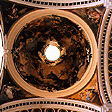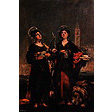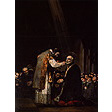
Goya's religious painting







 |
Religious painting was an important feature of Goya's work. It was the first he developed, and he continued to work in this genre with frequency until 1790. Goya changed from representing conventional, popular religious themes to an "enlightened" religiosity, more intimate and markedly emotional with no artificial or affected elements.
From his youth until 1775, Goya painted small devotional works, with a late Baroque and Rococco aesthetic. He also painted large murals that show his artistic and compositional gifts. Works such as the fresco of the Adoration of the Name of God (1771-1772) in the cupola of the Basilica del Pilar, or the scenes of the life of the Virgin in the church of the Carthusian monastery of Aula Dei (1772-1774), both in Zaragoza, are worthy examples. The decoration of the Regina Martyrum cupola (1780-1781) in the Basilica del Pilar confirmed Goya's status as a great painter. The culmination of his religious-decorative work was the painting of the dome in the Hermitage of San Antonio de la Florida (1798), which is a representation of a miracle of the Franciscan saint in which the figures, taken from daily life, are placed together in a highly expressive unity. He followed the Neo-Classical style, although stamping it with his personality in canvases such as Christ Crucified (1780) for which he was awarded the position of Academic of San Fernando, or the three works he painted for the monastery church of Santa Ana in Valladolid (1787). He later abandoned this type of work. The style of the time ran counter to his temperament and his conception of painting and art. After the War of Independence, he returned to religious painting with outstanding works such as Saints Justa and Rufina (1817) in the Cathedral in Seville, or the moving Last Communion of Saint Joseph of Calasanz (1819), one of the truly great religious works of the 19th and 20th century. Arturo Ansón |
|
| Adoration of the Name of God |  |
|
| Cartushian Monastery of Aula Dei |  |
|
| Cupola "Regina Martyrum" |  |
|
| San Antonio de la Florida (Detail) |  |
|
| Saints Justa and Rufina |  |
|
| Last Communion of Saint Joseph of Calasanz |
 |
InfoGoya 96 is an initiative of the University of Zaragoza, sponsored by the Institution Fernando el Católico of the Deputation of Zaragoza on an Apple Internet Server donated by Apple Computer. |    |